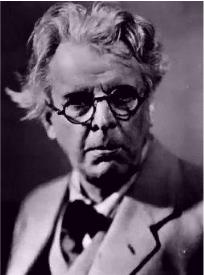Yeats' Hope for Salvation in Art
Yeats' poem "Sailing to Byzantium" contrasts two different realms: a country that is not hospitable to "old men" (perhaps Ireland) and "the holy city of Byzantium." Yeats is contrasting the realm of nature, which is fecund, full of life, but hard on the old, with that of art, which (according to Yeats) is eternal, beautiful, and even "holy." Note how the two break down in more detail:

Ireland (Nature)
- a country of the young
- full of birds, "salmon-falls,"mackerel-crowded seas"
- a place where everything is "begotten, born, and dies"
- a place of sensual music--the senses
- to be an "aged man" is to be "a paltry thing"
- the heart here is "fastened to a dying animal"
Byzantium (Art)
- a realm of sages, singing-masters of the soul
- holy fire
- "the artifice of eternity"
- a form of hammered gold (see icon image above on left)
- or an instrument that sings to keep the upper classes awake
- sings of the first realm, what is "past, passing, or to come."
For Yeats, art is "holy" and taught by "sages" because it seems to offer something larger and more lasting than the day-to-day world. Like Keats' Grecian urn, the iconic power of poetry seems to outlast the fading possibilities of human, bodily existence.
Contrast this poem with "The Circus Animals' Desertion," where his old themes leave him, the ladder to the realm of art is broken, and he is left with only "the foul rag-and-bone shop of the heart." Does Yeats finally find what he is seeking?

